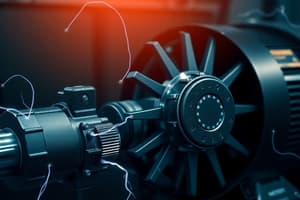Podcast
Questions and Answers
What is the SI unit for measuring power?
What is the SI unit for measuring power?
- Watt (W) (correct)
- Newton (N)
- Horsepower (hp)
- Joule (J)
Which equation correctly represents electrical power?
Which equation correctly represents electrical power?
- P = rac{W}{t}
- P = rac{1}{2}mv^2
- P = mgh
- P = IV (correct)
How does kinetic energy relate to mass and velocity?
How does kinetic energy relate to mass and velocity?
- KE = rac{2}{m}v
- KE = mv^2
- KE = mgh
- KE = rac{1}{2}mv^2 (correct)
Which of the following forms of energy is related to the motion of particles?
Which of the following forms of energy is related to the motion of particles?
What does the Law of Conservation of Energy state?
What does the Law of Conservation of Energy state?
Flashcards are hidden until you start studying
Study Notes
Power
- Definition: Power is the rate at which work is done or energy is transferred.
- Formula:
- ( P = \frac{W}{t} )
- Where ( P ) is power, ( W ) is work done, and ( t ) is time.
- ( P = \frac{W}{t} )
- Units:
- SI unit is the Watt (W), where ( 1 , W = 1 , \text{J/s} ).
- Other units include horsepower (hp) and kilowatt (kW).
- Types of Power:
- Mechanical Power: Power associated with mechanical systems.
- Electrical Power: Given by ( P = IV ), where ( I ) is current and ( V ) is voltage.
- Applications:
- Used in engines, electrical devices, and everyday appliances.
Energy
- Definition: Energy is the capacity to do work or produce change.
- Forms of Energy:
- Kinetic Energy: Energy of motion; ( KE = \frac{1}{2}mv^2 ).
- Potential Energy: Stored energy based on position; ( PE = mgh ) (gravitational potential).
- Thermal Energy: Related to temperature and motion of particles.
- Chemical Energy: Stored in bonds of chemical compounds.
- Nuclear Energy: Released during nuclear reactions.
- Law of Conservation of Energy: Energy cannot be created or destroyed, only transformed from one form to another.
- Units:
- SI unit is the Joule (J).
- Work-Energy Theorem: The work done on an object is equal to the change in its kinetic energy.
- Energy Transfer:
- Can occur through work, heat, or radiation.
- Power and Energy Relationship:
- Power is the rate of energy transfer, linking the two concepts.
Power
- Power measures the rate of work done or energy transferred over time.
- The formula for power is ( P = \frac{W}{t} ), where ( P ) is power in Watts, ( W ) is work in Joules, and ( t ) is time in seconds.
- The standard unit of power is the Watt (W), equivalent to one Joule per second (1 W = 1 J/s).
- Alternative units for power include horsepower (hp) and kilowatt (kW).
- Mechanical power pertains to the energy conversion or work done in mechanical systems.
- Electrical power is calculated using ( P = IV ), where ( I ) is electric current in Amperes and ( V ) is voltage in Volts.
- Applications of power include engines, electrical devices, and home appliances, all reliant on efficient energy transfer.
Energy
- Energy refers to the capacity to perform work or instigate change in a system.
- Forms of energy include:
- Kinetic Energy: Energy due to motion, calculated as ( KE = \frac{1}{2}mv^2 ), with ( m ) as mass and ( v ) as velocity.
- Potential Energy: Energy based on position, especially gravitational potential, expressed as ( PE = mgh ), where ( g ) is acceleration due to gravity.
- Thermal Energy: Associated with temperature and the kinetic motion of particles within a substance.
- Chemical Energy: Stored within the chemical bonds of compounds and released during reactions.
- Nuclear Energy: Energy released from nuclear reactions, such as fission and fusion.
- The Law of Conservation of Energy states that energy can neither be created nor destroyed; it merely changes from one form to another.
- The standard unit of energy is the Joule (J).
- The Work-Energy Theorem posits that the work done on an object results in a change in kinetic energy.
- Energy can be transferred through methods such as work, heat, or radiation.
- Power and energy are interconnected—power represents the rate at which energy is transferred or transformed.
Studying That Suits You
Use AI to generate personalized quizzes and flashcards to suit your learning preferences.




